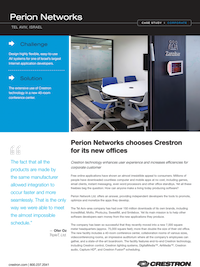Voracious for Video


The demand for high quality video across the enterprise is growing exponentially. What’s the best way to handle all of that data?
Managing AV on the IT network is no longer an option; it’s absolutely necessary to meet the needs of dynamic knowledge workers and students. From sales and marketing, to HR and education, high quality video now plays a critical role in meetings, classrooms, and communications across virtually every business segment and functional area. And the demand for video is only increasing.
How your customers choose to manage and distribute video data is critical not only to the long-term health of their network, but also to ensuring optimal user experiences that drive engagement and productivity rather than delays and frustration.
The rise of streaming
Just as Netflix® has changed the way people watch TV, network video is changing the way every business and university works. Network video must be a central component of an IP network strategy and plan, as it is by far the best solution for transmitting video long distances. But network video also comes with latency and bandwidth concerns. Moreover, network video doesn’t support protected content or applications where the unparalleled quality of uncompressed video is necessary, such as for radar, CAD imagery, and medical diagnostics.
When shrinkage is a good thing
AV over IP leverages existing network infrastructure for video distribution, with network video solutions employing compression technology to fit high-bandwidth video over lower-bandwidth links via a standard Ethernet cable. The two main compression formats are H.264 and JPEG2K, each offering benefits and tradeoffs. Rather than breaking down the algorithms behind each type of compression, the most important factors to consider are that H.264 optimizes video packets to consume less bandwidth, while JPEG2 optimizes video for reduced latency.
A daily selection of features, industry news, and analysis for AV/IT professionals. Sign up below.
Low-bandwidth H.264 streams can use as little as 1MBps up to 25Mbps. They play nicely in most network environments, allowing many streams per link and the ability to interoperate on corporate networks. The “cost” is in latency, which can easily add up to a half second of delay in the video stream. Best practice dictates that acceptable latency for in-room applications is < 50ms. Anything more than that creates dissonance between the presenter, the presentation, and the audience. This makes H.264 the preferred choice for cameras, signage, long distance transmission, such as overflow rooms, but not for in-room extension where mouse and keyboard lag is jarring.
JPEG2K video is much higher bandwidth, using up to 880 Mbps of the 1Gb Ethernet link. As a result they generally require a network cable run, similar to that required for supporting uncompressed video. The benefit, some would suggest, is lower latency. However, there is still up to 120ms delay, which is still beyond the tolerance level of the average person.
No compromise video
The expectation for meetings, presentations, and collaboration is zero latency and the highest picture quality possible, up to and including 4K. This isn’t possible with network video. HDMI®, HDBaseT®, and fiber infrastructure is best for these applications.
However, they all have distance limitations. HDMI can only travel 30 feet, HDBaseT can go up to 330 feet, and fiber can go either 1,000 feet (multimode) or 7 miles (single mode). Installing new and more expensive single mode fiber can be costly, plus it can’t transmit video to another geographic location, such as an international office or satellite campus. Network video is the best solution for these applications, where latency is not noticeable or a concern.
So what’s the enterprise video solution?
There’s no silver bullet solution that miraculously erases the performance divide between network video and zero-latency, uncompressed video solutions. Choosing one or the other is not an option. It requires robust, scalable enterprise infrastructure that supports both types of distribution.
Crestron DigitalMedia™ provides the unparalleled advantage of supporting both network video and point-to-point video distribution on the same platform. Systems scale with ease, allowing you to choose the optimum solution on an input-by-input and output-by-output basis. Use point-to-point for zero-latency, full-bandwidth connections within the room, and network video for worldwide distribution. To learn more visit crestron.com/dm and visit Booth C7008 at InfoComm16 in Las Vegas to our latest DM solutions in action.
Additional Resources

The new headquarters includes more than 50 meeting rooms, all standardized on Crestron DigitalMedia™. Larger rooms use a DM 8X8 or 32X32 switcher, transmitters, receivers and scalers. Smaller rooms use a DMPS-300-C Presentation System

The forty-room conference center is built on the Crestron DigitalMedia™ platform. AirMedia® is used throughout; DMPS-300-C presentation systems are in the conference rooms; the executive meeting room and auditorium use DM 16x16 matrices with 4K support.

The collaborative learning studio relies on Crestron DigitalMedia™. It’s so popular that more rooms are already planned. Students are no longer on social media during class. Now they are “eager to participate; they feel more motivated and involved.”
The AVNetwork staff are storytellers focused on the professional audiovisual and technology industry. Their mission is to keep readers up-to-date on the latest AV/IT industry and product news, emerging trends, and inspiring installations.
